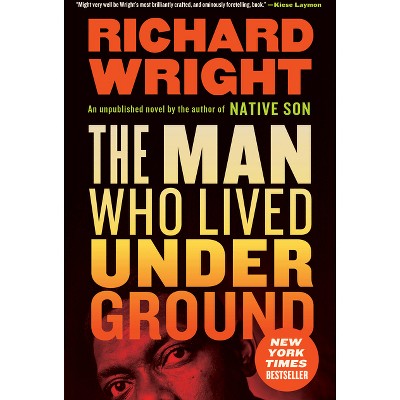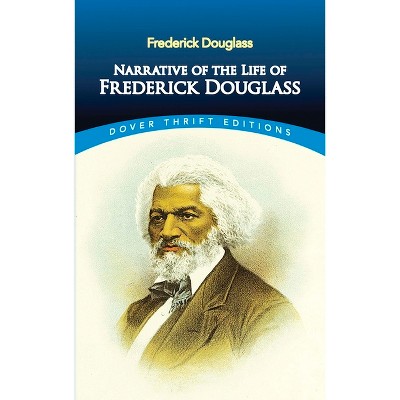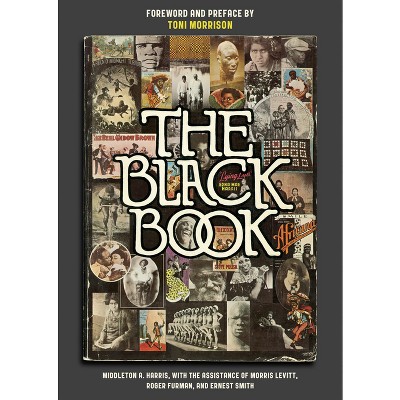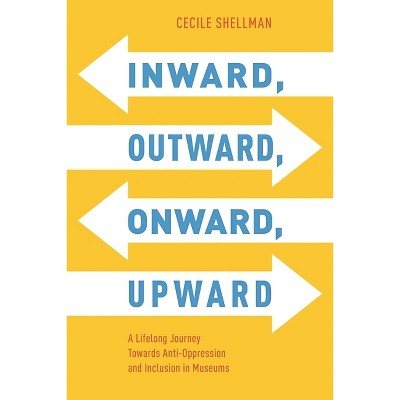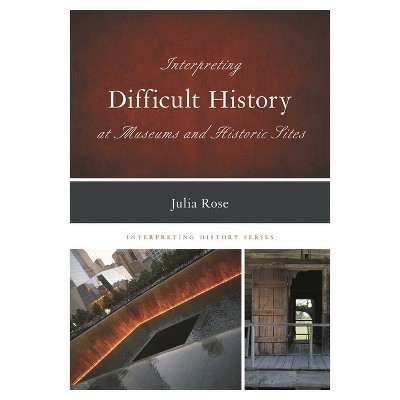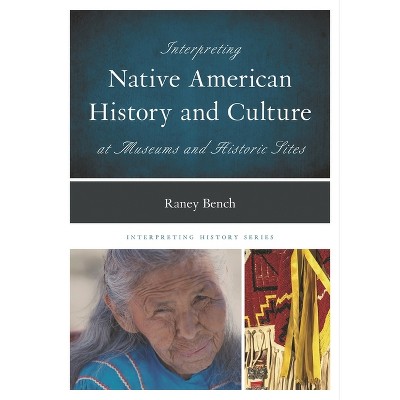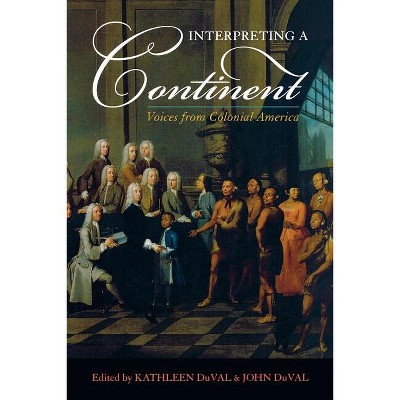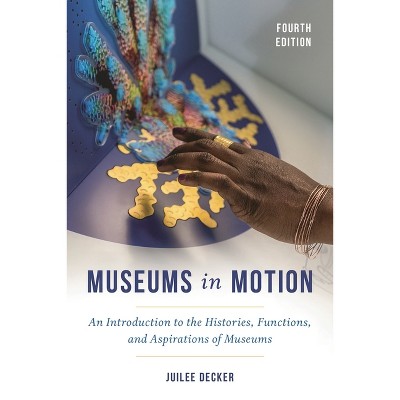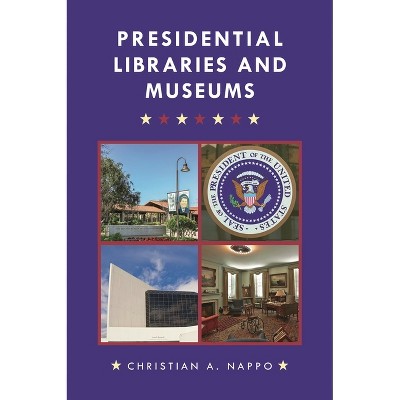Sponsored

Interpreting African American History and Culture at Museums and Historic Sites - (Interpreting History) by Max A Van Balgooy (Paperback)
$51.00
In Stock
Eligible for registries and wish lists
Sponsored
About this item
Highlights
- In this landmark guide, nearly two dozen essays by scholars, educators, and museum leaders suggest the next steps in the interpretation of African American history and culture from the colonial period to the twentieth century at history museums and historic sites.
- About the Author: Max A. van Balgooy is president of Engaging Places LLC, a design and strategy firm that connects people and historic places.
- 234 Pages
- History, United States
- Series Name: Interpreting History
Description
About the Book
This diverse anthology addresses both historical research and interpretive methodologies, including investigating church and legal records, using social media, navigating sensitive or difficult topics, preserving historic places, engaging students and communities, and strength...Book Synopsis
In this landmark guide, nearly two dozen essays by scholars, educators, and museum leaders suggest the next steps in the interpretation of African American history and culture from the colonial period to the twentieth century at history museums and historic sites. This diverse anthology addresses both historical research and interpretive methodologies, including investigating church and legal records, using social media, navigating sensitive or difficult topics, preserving historic places, engaging students and communities, and strengthening connections between local and national history.Case studies of exhibitions, tours, and school programs from around the country provide practical inspiration, including photographs of projects and examples of exhibit label text.
Highlights include:
- Amanda Seymour discusses the prevalence of "false nostalgia" at the homes of the first five presidents and offers practical solutions to create a more inclusive, nuanced history.
- Dr. Bernard Powers reveals that African American church records are a rich but often overlooked source for developing a more complete portrayal of individuals and communities.
- Dr. David Young, executive director of Cliveden, uses his experience in reinterpreting this National Historic Landmark to identify four ways that people respond to a history that has been too often untold, ignored, or appropriated--and how museums and historic sites can constructively respond.
- Dr. Matthew Pinsker explains that historic sites may be missing a huge opportunity in telling the story of freedom and emancipation by focusing on the underground railroad rather than its much bigger "upper-ground" counterpart.
- Martha Katz-Hyman tackles the challenges of interpreting the material culture of both enslaved and free African Americans in the years before the Civil War by discussing the furnishing of period rooms.
- Dr. Benjamin Filene describes three "micro-public history" projects that lead to new ways of understanding the past, handling source limitations, building partnerships, and reaching audiences.
- Andrea Jones shares her approach for engaging students through historical simulations based on the "Fight for Your Rights" school program at the Atlanta History Center.
- A exhibit on African American Vietnam War veterans at the Heinz History Center not only linked local and international events, but became an award-winning model of civic engagement.
- A collaboration between a university and museum that began as a local history project interpreting the Scottsboro Boys Trial as a website and brochure ended up changing Alabama law.
A list of national organizations and an extensive bibliography on the interpretation of African American history provide convenient gateways to additional resources.
Review Quotes
Interpreting African-American history at historic sites is an essential but often complicated task. This timely and important volume seeks to improve and suggest successful plans for historical interpretation, and contains nearly two dozen essays spanning from the colonial period to the 21st century. It embraces a myriad of research methods and strategies for interpretation, including the use of social media, archival and documentary research, outreach programmes as well as instructing interpreters how to manage conflict and difficult questions. . . .This volume offers a rich and interesting insight into the world of public history. . . .[and] provides an engaging and fascinating account of how African-American history is interpreted today. Historical interpreters have an opportunity to explore, ask questions, dig deeper and engage an audience whilst navigating the tensions of American history. This volume celebrates contributions and successes, but we need to recognise that many historic sites have much to improve when confronting the legacy of slavery.
Museums and historic sites wishing to devise, or revise., their interpretive programs to better synthesize African American history will find several of the practical case studies in this volume quite useful. Those teaching public history in universities, particularly museum interpretation, historic site interpretation, and museum education courses, may also find it beneficial to assign this book as a way to help students understand current issues in the field. Few worthwhile historic sites and museums can fail to acknowledge the importance of expanding their programs to include the histories of diverse communities. Now, as van Balgooy and the essay authors clearly demonstrate, the challenge is to embed these histories within the sites themselves.
What a gift it will be when museums and historic sites can help our publics understand that they are shaped, touched, and made better by African American history, all day, every day. The essays in this volume give me hope that that day is not too far distant.
About the Author
Max A. van Balgooy is president of Engaging Places LLC, a design and strategy firm that connects people and historic places. He works with a wide range of historic sites on interpretive planning and business strategy, from Drayton Hall to Taliesin West. These experiences provide a rich source of ideas for EngagingPlaces.net, where he blogs regularly about the opportunities and challenges facing historic sites and house museums. He serves on the AASLH Council and teaches in the museum studies program at George Washington University, and received his degrees in history from Pomona College and the University of Delaware (Hagley Fellow).Dimensions (Overall): 10.0 Inches (H) x 7.1 Inches (W) x .5 Inches (D)
Weight: 1.0 Pounds
Suggested Age: 22 Years and Up
Number of Pages: 234
Genre: History
Sub-Genre: United States
Series Title: Interpreting History
Publisher: Rowman & Littlefield Publishers
Theme: State & Local, General
Format: Paperback
Author: Max A Van Balgooy
Language: English
Street Date: December 1, 2014
TCIN: 1004175886
UPC: 9780759122796
Item Number (DPCI): 247-28-8562
Origin: Made in the USA or Imported
If the item details aren’t accurate or complete, we want to know about it.
Shipping details
Estimated ship dimensions: 0.5 inches length x 7.1 inches width x 10 inches height
Estimated ship weight: 1 pounds
We regret that this item cannot be shipped to PO Boxes.
This item cannot be shipped to the following locations: American Samoa (see also separate entry under AS), Guam (see also separate entry under GU), Northern Mariana Islands, Puerto Rico (see also separate entry under PR), United States Minor Outlying Islands, Virgin Islands, U.S., APO/FPO
Return details
This item can be returned to any Target store or Target.com.
This item must be returned within 90 days of the date it was purchased in store, shipped, delivered by a Shipt shopper, or made ready for pickup.
See the return policy for complete information.
Trending Non-Fiction

$19.31
was $20.98 New lower price
4 out of 5 stars with 64 ratings

$18.28
was $19.58 New lower price
4.7 out of 5 stars with 17 ratings

$4.59
MSRP $7.99
Buy 2, get 1 free select books
4.8 out of 5 stars with 123 ratings

$6.20
MSRP $10.95
Buy 2, get 1 free select books
4.8 out of 5 stars with 33 ratings

$7.09
MSRP $9.99
Buy 2, get 1 free select books
4.9 out of 5 stars with 46 ratings
